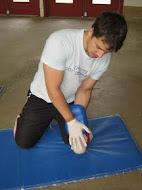Where did Basic Life Support come from?

The concept of Basic Life Support was created by the American Heart Association, to serve as a set of guidelines to follow when giving CPR. However, it is only the first level of medical care that a victim of cardiac arrest receives. The skills associated with BLS are in fact, very basic, being able to stabilize the victim so he or she can be brought to a hospital for more advanced medical management. BLS is typically performed by EMTs – emergency medical technicians – but a layperson who has trained in BLS can also perform it in times of an emergency. There are three skills involved in BLS:
- Compression. Chest compressions is the most important part of CPR. Because the heart stops in the event of a cardiac arrest, the compressions manually pump the heart in the absence of spontaneous circulation of blood in the body. Compression rate has to be at least 100 per minute, mimicking a normal heart rate. In adults, the chest is compressed by 2 inches while in infants and toddlers the chest is compressed by 1.5 inches to 2 inches.
- Ventilation. Ventilation only comes second to compressions because the lack of oxygen delivery to the tissues is not due to poor respiration but poor circulation. Victims of cardiac arrest typically experience irregular breathing but getting blood circulating through the body is prioritized. The rate for chest compressions and rescue breaths is 30:2, making up one cycle.
- Defibrillation. When laypersons take BLS training, they are introduced to the AED or automated external defibrillator. An AED is simply attached to the chest and gives out automatic levels of electricity to the victim once it has been activated. Manual defibrillation is taught in more advanced courses for people who work in healthcare, called Advanced Life Support training.
What classes are available under the BLS concept?
At our six providers all over the country, there are three BLS courses available. These three courses are approximately four hours long, one offered for laypersons while the other two are for healthcare providers (HCPs). Only one of the courses has a re-certification class, so if you took the other two and your credential expires, you have no choice but to take the program again.
- Basic CPR training (Heartsaver CPR) – Lasts 4 hours long; tailored for the public
- Basic CPR training (Heartsaver CPR C) – Lasts 4.5 hours long; tailored for HCPs
- Basic Life Support for HCPs – Lasts 4.5 hours; teaches both one and two person CPR rescue
- Basic Life Support for HCPs re-certification – Lasts 4 hours long
You can enroll in any of our training programs, depending on what kind of certificate you need. Certification is offered for all our basic and advanced courses, with a validity of two years before they have to be renewed. We also emphasize that students sign up for re-certification early; we do not allow rescuers with expired credentials to sign up for a re-certification class.
